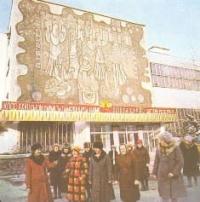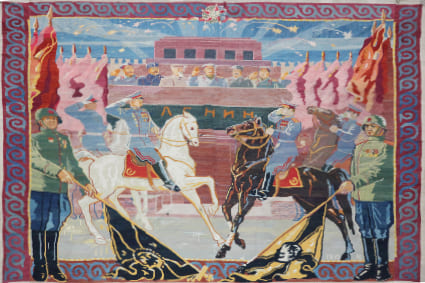Вы здесь
Almaty carpet factory.

Excursion walks to Almaty Art Museum.
“The wealth of the house is the carpet; If you lay it down, it’s a warm flooring; if you hang it up, it’s a decoration.”
Kazakh proverb.
Kazakh carpet weaving.
The Almaty carpet factory was located on Komsomolskaya street (since 1991 Tole bi street), 187 between Zharokova and Auezov streets in the Sovetsky district (now Almalinsky) in the city of Almaty. The carpet and knitwear factory, located in the city of Alma-Ata, was created in 1936 as the cooperative trade artel “Kovrovshchitsa”, since 1960 - the Alma-Ata Carpet and Weaving Factory, since 1972 - the Alma-Ata Carpet Factory.
The factory has been named after V.V. Tereshkova since 1964. The factory had 7 main and auxiliary workshops and sections. In 1962, handlooms were replaced by mechanical 2-sheet carpet weaving machines.
The main types of products were: jacquard carpets (2-line, machine made; 4-color rod, with cut pile; 2-color rod, with continuous pile), hand-made pile carpets; smooth rod tracks and jacquard rod tracks. The company produced carpets and rugs of various types from natural sheep, camel and goat wool.
“Carpet weaving is one of our most ancient cultural traditions. Kazakhs were constantly nomadic, which means they needed mobile warm things - felt mats, carpets. At first this was all done by hand, then machines appeared.
In Soviet times, carpet was a scarcity and even a luxury item - it was difficult to buy it just like that, and there was even a waiting list for it,” says Oleg Belonosov. In the spring of 1945, the factory received a special order from the government to make special tapestries in honor of the Victory.
In order to weave these tapestries, a special dye was needed. It was very difficult to find at that time, and the museum staff traveled to several neighboring countries in search of these paints.”
- “As a result, the order was completed, and now these tapestries can be seen in the Museum of the Republic of Kazakhstan in Almaty, they are in excellent condition,” said the archive expert.
“Due to the opening of borders, Turkish carpets began to be supplied to the country. They were easy to wash, were much brighter, and all had a different, original pattern. But these carpets were synthetic and did not stand next to the Almaty carpets made of natural wool. But the residents of the former Soviet Union didn’t think about it at all then,” recalls Oleg Belonosov.
In 1992, the Alma-Ata carpet factory was privatized and transformed into the private joint stock company Almaty Kilem JSC. Before liquidation, it was equipped with modern German equipment. According to special orders, the factory produced carpets with portrait images of Abai, Zhambyl, M. Auezov, S. Seifullin, S. Mukanov and other prominent figures of literature and art.
For 25 years, Klara Akhmetkhanovna Niyazbaeva was the director of the carpet factory. Today the carpet factory does not exist - the equipment, machines, production areas have been sold. Since 2007, the production area has been used for the Tumar and Sulpak shopping center.
Geographic coordinates of Almaty carpet factory: N43°15'07.62" E76°53'58.13"
Note:
If you are using geographic coordinates for Google Earth or Google Maps navigation systems, you must remove the last two digits from geographic coordinates and " (hundredths of a second) and enter the result in the input line. Example: N51°44'09.67" E72°39'40.81" = N51°44'09 E72°39'40

Authority and photos by:
https://prometej.info/uteryannoe-nasledie-almaty/#link-4







